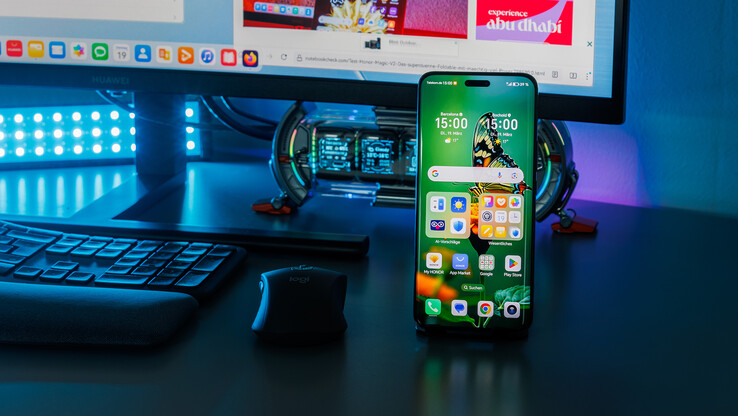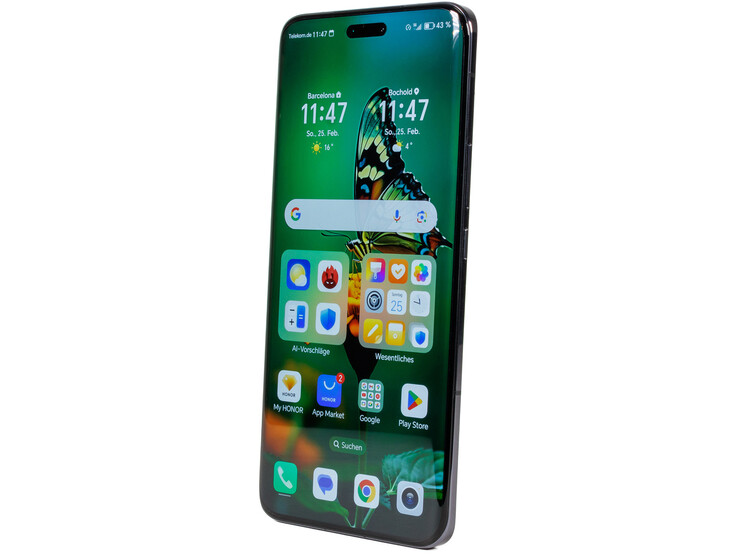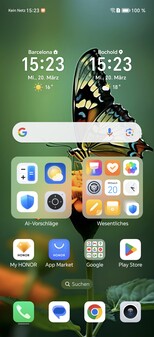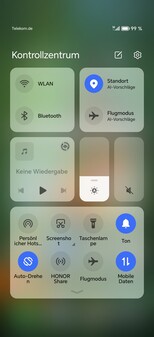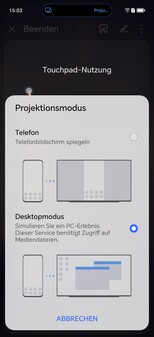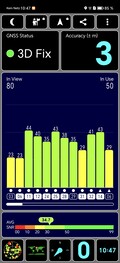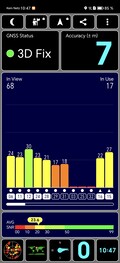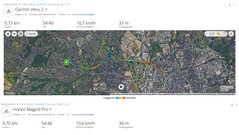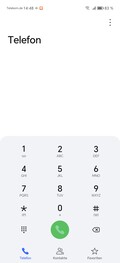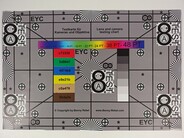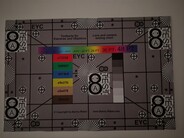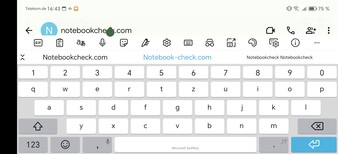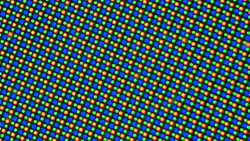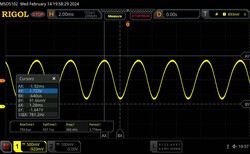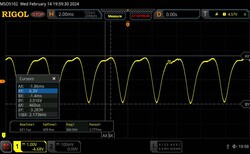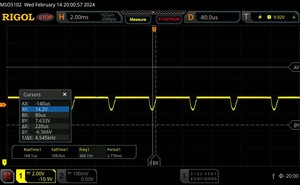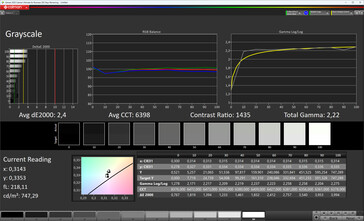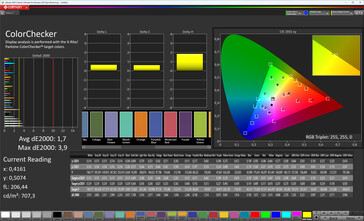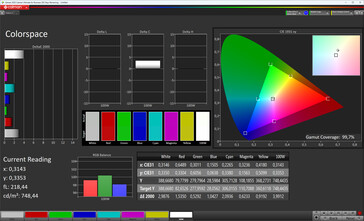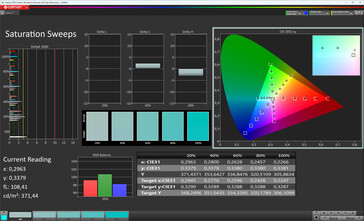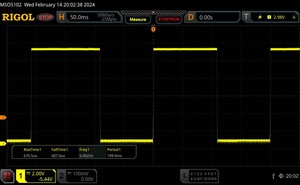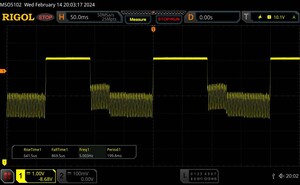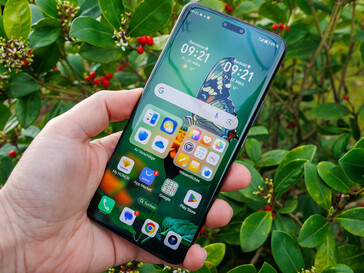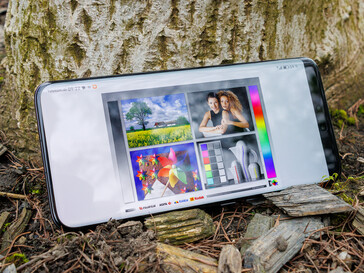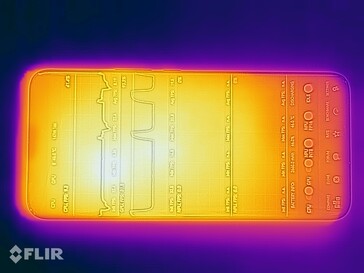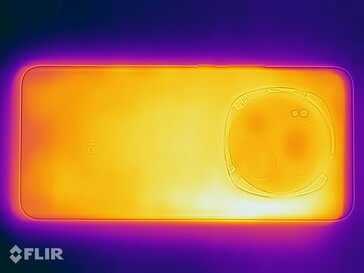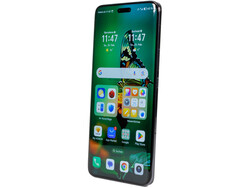Honor Magic6 Pro review - The smartphone with magical battery life
The Honor Magic6 Pro is the successor to the Magic5 Pro, which impressed last year and only revealed a few weaknesses. These included rather mediocre SoC cooling, the lack of UWB, and the absence of 6 GHz WLAN.
The Magic6 Pro has a fresh design and a faster processor and also offers many other functions that a high-end smartphone should have. The focus is particularly on the super-bright display, the powerful camera setup, which uses a periscope zoom with 180 MP for the first time, and the large battery with silicon-carbon technology.
The Honor Magic6 Pro is only launching in Europe in one storage version (12/512 GB) with a recommended retail price of EUR 1,300.
Possible competitors in comparison
Rating | Date | Model | Weight | Drive | Size | Resolution | Price |
|---|---|---|---|---|---|---|---|
| 90.6 % v7 (old) | 05 / 2024 | Honor Magic6 Pro SD 8 Gen 3, Adreno 750 | 229 g | 512 GB UFS 4.0 Flash | 6.80" | 2800x1280 | |
| 91.1 % v7 (old) | 05 / 2024 | Samsung Galaxy S24 Ultra SD 8 Gen 3 for Galaxy, Adreno 750 | 232 g | 256 GB UFS 4.0 Flash | 6.80" | 3120x1440 | |
| 89 % v7 (old) | 12 / 2023 | Google Pixel 8 Pro Tensor G3, Mali-G715 MP7 | 213 g | 128 GB UFS 3.1 Flash | 6.70" | 2992x1344 | |
| 90.7 % v7 (old) | 10 / 2023 | Apple iPhone 15 Pro A17 Pro, A17 Pro GPU | 187 g | 128 GB NVMe | 6.10" | 2556x1179 | |
| 89.8 % v7 (old) | 01 / 2024 | Xiaomi 14 SD 8 Gen 3, Adreno 750 | 193 g | 256 GB UFS 4.0 Flash | 6.36" | 2670x1200 |
Case - Magic6 Pro with NanoCrystal Shield
The Honor Magic6 Pro is available in Black and Epi-Green. Compared to its predecessor, it is ten grams heavier, slightly narrower, and taller. However, it still feels good in the hand.
The build quality is impressive. Although the high-gloss aluminum frame is susceptible to fingerprints, it gives the Honor smartphone a high level of stability. No cracking or creaking can be heard when trying to twist it. Honors NanoCrystal Shield is used as the protective glass, which promises ten times the shatter resistance of conventional glass. Honor claims that it can withstand drops from a height of 1.5 meters onto a rough surface (e.g. asphalt) or even from two meters onto a wooden surface without damage. The gaps are narrow and even.
The Magic6 Pro is also IP68-certified against the ingress of dust and water. It is, therefore, both dustproof and waterproof.
Features - USB 3.2 and an IR blaster
The Magic6 Pro has a fast USB 3.2 port (Gen. 1), which can also use external peripherals and storage media thanks to USB OTG. The latter can be formatted with FAT, FAT32, exFAT, or NTFS. In the copy test with an external hard disk (Samsung 980 Pro in an Asus ROG Strix Arion, USB 3.2 Gen. 2), the Honor smartphone achieved an average of 249.78 MB/s. Wired image transfer is also possible on the port, including an optional desktop mode.
Both Miracast and Cast+ are supported for wireless image transmission. In addition to NFC, an IR transmitter is integrated at the top of the Magic6 Pro, which can be used to remotely control compatible devices such as televisions, receivers, air conditioning systems, or cameras.
However, there is still no ultra-wideband chip (UWB), and Bluetooth 5.3 is not the latest version either, meaning that modern Bluetooth LE and the LC3 codec are missing. Auracast is also not yet integrated into the system.
Software - MagicOS 8.0 and five years of updates
The Magic6 Pro comes with Google Android 14, over which Honor runs its own MagicOS 8.0 user interface (UI). AI functions are also at the heart of Honor - in particular the so-called Magic Portal (see video below). This allows content on the display to be dragged and dropped to the edge of the screen, and the system suggests suitable apps based on the selected content. An address from an email or browser can be dragged to Google Maps for immediate navigation. Photos, on the other hand, can be dragged directly to suitable social media apps or sales platforms. This already works very well in everyday life and saves time.
A local LLM (Large Language Model), which is based on Llama 2, will be delivered later via an update. This works similarly to ChatGPT and Co. but does not require a cloud connection. The eye control shown at the MWC is also not yet final but will also be available via an update.
In addition to the usual system apps, Honor also installs a few third-party apps such as Facebook, TikTok, and WPS Office, but these can all be uninstalled. The Magic6 Pro will be supplied with security patches for five years monthly. The smartphone will also receive a total of four major updates, i.e. up to Android 18.
Communication and GNSS - Wi-Fi 7, but without 6 GHz band
Mobile internet users have a broad frequency band portfolio at their disposal, and with 5G Sub6, the latest standard is also supported.
The same can be said regarding Wi-Fi, as the Magic6 Pro supports Wi-Fi 7 (IEEE 802.11 a, b, g, n, ac, ax, be), but only in dual-band operation at 2.4 and 5.0 GHz. The Honor smartphone does not support the fast 6.0 GHz band with less interference. The transfer rates to our reference router Asus ROG Rapture GT-AXE11000 are comparatively low since the Magic6 Pro can only use Wi-Fi 6 at best with this model.
We then used a TP-Link Archer BE800 to test the connection with Wi-Fi 7 in the 5 GHz range. The stability is similarly high, and the smartphone achieves significantly higher data rates with an average of 1,638 MBit/s (sending) and 1,643 MBit/s (receiving). At the peak, even up to 1,966 MBit/s were possible when sending.
| Networking | |
| Honor Magic6 Pro | |
| iperf3 receive AXE11000 | |
| iperf3 transmit AXE11000 | |
| Samsung Galaxy S24 Ultra | |
| iperf3 receive AXE11000 | |
| iperf3 transmit AXE11000 | |
| iperf3 transmit AXE11000 6GHz | |
| iperf3 receive AXE11000 6GHz | |
| Google Pixel 8 Pro | |
| iperf3 receive AXE11000 | |
| iperf3 transmit AXE11000 | |
| iperf3 transmit AXE11000 6GHz | |
| iperf3 receive AXE11000 6GHz | |
| Apple iPhone 15 Pro | |
| iperf3 transmit AXE11000 6GHz | |
| iperf3 receive AXE11000 6GHz | |
| Xiaomi 14 | |
| iperf3 receive AXE11000 | |
| iperf3 transmit AXE11000 | |
| iperf3 transmit AXE11000 6GHz | |
| iperf3 receive AXE11000 6GHz | |
| Average of class Smartphone | |
| iperf3 receive AXE11000 | |
| iperf3 transmit AXE11000 | |
| iperf3 transmit AXE11000 6GHz | |
| iperf3 receive AXE11000 6GHz | |
Outdoors, the Magic6 Pro locates its user very quickly and precisely. Indoors, it takes a little longer but accuracy is still decent.
On a bike ride, we compare the accuracy of the route tracking with the Garmin Venu 2 fitness smartwatch. Neither device works flawlessly, but they are very close to each other, and the Honor smartphone is even slightly more accurate at the turning point. It also delivers very accurate altitude values.
Phone functions and voice quality
The Honor Magic6 Pro supports dual messenger apps, VoLTE, and Wi-Fi calls and can accommodate two nanoSIM cards. The second SIM can be deactivated in favor of an eSIM, 5G is available for both active SIMs, but the mobile data cannot be switched automatically if the reception with one SIM is poor.
The voice quality is very natural when held to the ear, and most ambient noise is reliably filtered out, even with more intrusive noise. The loudspeaker mode delivers an appealing quality and also a long microphone range. Even at a distance of almost four meters from the smartphone, we were still easy to understand but then sounded a little tinny.
Cameras - Many possibilities with three times 50 MP plus 180 MP
The front camera of the Honor Magic6 Pro has a generous 50 MPix resolution and uses pixel binning so that the finished photos are around 12 MPix in size. Videos can be recorded in Ultra HD with up to 30 FPS and Full HD with up to 60 FPS. Despite the lack of autofocus, the images are very well-balanced and can even impress in less-than-ideal lighting conditions.
All of the Magic6 Pro's sensors come from OmniVision and, according to Honor, were developed in an exclusive collaboration. The main sensor works with 50 MP resolution and can rely on optical image stabilization (OIS). The variable aperture can automatically switch between f/1.4 and f/2.0 to optimally adapt to the lighting conditions. The results are impressive. In daylight, the Magic6 Pro impresses with rich contrasts and an appealing dynamic range. In low light, comparatively good shots are also possible, although the Pixel 8 Pro achieves even clearer contours in night mode. In return, we find the tuning more harmonious thanks to the warmer white balance. A special sports mode is also integrated for moving subjects, which not only works with particularly fast shutter speeds but also captures images before the shutter button is pressed in order to create an image that is as dynamic and sharp as possible using an algorithm. This works quite well with people, but smaller objects are more difficult to capture.
The ultra-wide angle can also fall back on a generous 50 MP and also offers a macro function. Honor also uses pixel binning here, which does not always benefit the photos, as they can become muddy at the edges, and the sharpness in the center of the image is not optimal. This should be improved again with an update.
In fact, the brand-new periscope camera is also macro-capable and delivers a record-breaking 180 MP with 2.5x optical magnification, including OIS. Even 100x magnification is possible digitally. The optical imaging performance is really good and even at 5x hybrid zoom, the Magic6 Pro still delivers convincing results, but the quality drops sharply starting from 10x magnification, where a Galaxy S24 Ultra is visibly better. Nevertheless, the results can be quite useful for social media or for making distant objects legible. Although the image stabilization is very effective, it tends to be jerky at longer focal lengths.
At best, the Honor cell phone records videos in Ultra HD with up to 60 FPS, including HDR. If you want to use the super night mode, this is reduced to 24 FPS. In movie mode, it is also possible to record LOG videos with an increased dynamic range, but these must be post-processed in any case. However, this can also be done directly on the Magic6 Pro. However, Honor cheats with the optional 21:9 format. Instead of adding more pixels in width, the image height is simply reduced so that the supposed 4K recording only uses 3,840 x 1,644 instead of 5,120 x 2,160 pixels. As such, the recording quality is really good.
| Mode | Aspect ratios | Resolution |
|---|---|---|
| Photo | Full, 1:1, 4:3 | 12 / 50 MP |
| Pro (RAW/JPG-L) | 4:3 | 50 MP |
| Pro (JPG) | Full, 1:1, 4:3 | 12 MP |
| Video | 16:9, 21:9 | HD (30/60 FPS), Full HD (30/60 FPS), Ultra HD (30/60 FPS) |
| Film | 16:9, 21:9 | Full HD (24/30/60 FPS), Ultra HD (24/30/60 FPS) |
| Slow motion | 16:9 | Full HD (120 / 240 FPS) |
Image comparison
Choose a scene and navigate within the first image. One click changes the position on touchscreens. One click on the zoomed-in image opens the original in a new window. The first image shows the scaled photograph of the test device.
Main cameraMain cameraUltra wide-angle5x ZoomLow-LightUnder controlled lighting conditions, the Honor Magic6 Pro delivers a very balanced and uniform sharpness. The ColorChecker shows higher DeltaE deviations, particularly in the blue tones, which lead to a strong saturation. The grayscale is also slightly too dark and too warm.
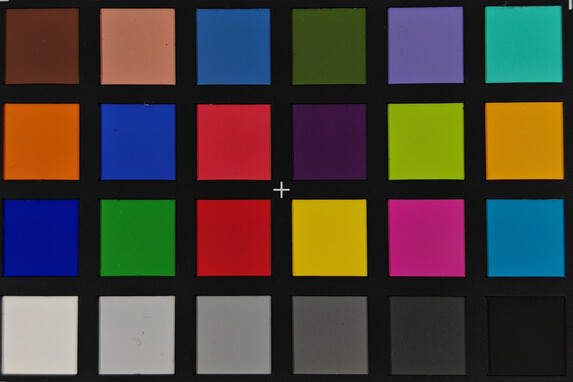
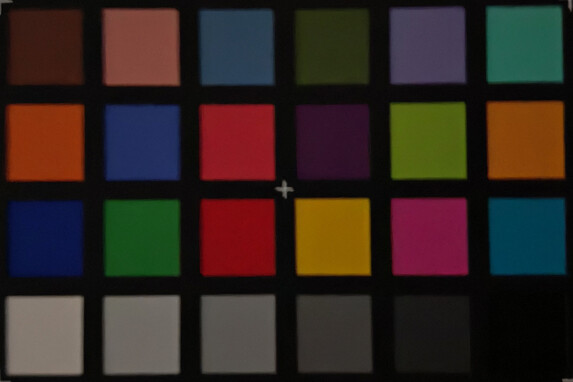
Accessories and warranty - Magic6 Pro comes without a power adapter
The scope of delivery of the Magic6 Pro only includes a USB cable (Type-A to Type-C) and a SIM tool. A power adapter must be purchased as an option.
Suitable power adapters that support the fast charging standard of the Honor smartphone are available from 17 euros. Suitable cases also start in this price range.
The Magic6 Pro comes with a 24-month warranty in Germany.
Input devices & operation - Still with 3D face recognition
The Magic6 Pro's capacitive touchscreen is protected by a factory-installed film. Although its gliding properties are also good, the glass surface is even better. Inputs are always implemented quickly and precisely.
Biometric security is ensured by an optical fingerprint scanner in the display. Its recognition rates are very good, and the smartphone is unlocked quickly. Alternatively, or additionally, 3D facial recognition is available via the front camera and the adjacent ToF sensor, which does not require any compromises in terms of speed or security. Both the user's finger and facial data are stored locally on the smartphone and protected by the dedicated Honor S1 security chipset.
The linear vibration motor provides crisp and noticeable haptic feedback and is not too loud. The Magic6 Pro also offers knuckle gestures, a one-hand mode, touchless gestures, and much more.
Display - 5,000 cd/m² is rarely possible
The 6.8-inch LTPO OLED display of the Honor Magic6 Pro offers an extended Full HD resolution and can dynamically adjust the refresh rate between 1 and 120 Hz. With Dolby Vision, it now supports all modern HDR standards.
As expected, the brightness also increases compared to its predecessor and now reaches an average of 1508 cd/m² in a pure white display with the ambient light sensor activated, which is in line with the manufacturer's specifications. In the APL18 measurement, the brightness in the center of the screen drops to 1,445 cd/m², and we cannot measure more than 1,385 cd/m² with YouTube HDR playback - a far cry from the proclaimed peak brightness of 5,000 cd/m². When asked, Honor confirmed that this is the peak brightness for HDR photos.
If you adjust the brightness manually, up to 778 cd/m² is available. The minimum brightness is quite low, but 2.59 cd/m² can still be quite bright, especially in the dark. An optional circadian night display is available in the settings, which controls the color temperature of the display to reduce eye strain.
The high-frequency PWM dimming with up to 4,320 Hz is in the same vein, although it only reaches its full performance from a manual display brightness of around 15 percent. This is significantly lower at minimum brightness in particular, and we can also detect low-frequency flickering with a high amplitude at 360 Hz. We can rule out temporal dithering as the cause. This is probably a comparatively high-frequency black frame insertion (BFI), which is used to reduce motion blur and protect the display against burn-in. In the series of measurements with a fixed zoom level, the amplitude curve at minimum brightness looks quite flat, but this is due to the scaling; an enlarged version of the amplitude at 15 percent can be seen in the info box. For sensitive people, discomfort cannot be completely ruled out, but it will be difficult to find an OLED that is easier on the eyes.
| |||||||||||||||||||||||||
Brightness Distribution: 89 %
Center on Battery: 1575 cd/m²
Contrast: ∞:1 (Black: 0 cd/m²)
ΔE ColorChecker Calman: 1.7 | ∀{0.5-29.43 Ø4.77}
ΔE Greyscale Calman: 2.4 | ∀{0.09-98 Ø5}
99.7% sRGB (Calman 2D)
Gamma: 2.22
CCT: 6398 K
| Honor Magic6 Pro OLED, 2800x1280, 6.8" | Samsung Galaxy S24 Ultra Dynamic AMOLED 2X, 3120x1440, 6.8" | Google Pixel 8 Pro OLED, 2992x1344, 6.7" | Apple iPhone 15 Pro Super Retina XDR OLED, 2556x1179, 6.1" | Xiaomi 14 OLED, 2670x1200, 6.4" | Honor Magic5 Pro OLED, 2848x1312, 6.8" | |
|---|---|---|---|---|---|---|
| Screen | -27% | 11% | 16% | 5% | -10% | |
| Brightness middle (cd/m²) | 1575 | 1317 -16% | 1510 -4% | 1092 -31% | 1043 -34% | 1291 -18% |
| Brightness (cd/m²) | 1508 | 1365 -9% | 1467 -3% | 1086 -28% | 1052 -30% | 1289 -15% |
| Brightness Distribution (%) | 89 | 94 6% | 92 3% | 99 11% | 96 8% | 96 8% |
| Black Level * (cd/m²) | ||||||
| Colorchecker dE 2000 * | 1.7 | 3.4 -100% | 1.1 35% | 0.91 46% | 1.1 35% | 1.7 -0% |
| Colorchecker dE 2000 max. * | 3.9 | 5 -28% | 3.8 3% | 1.95 50% | 2.8 28% | 4.4 -13% |
| Greyscale dE 2000 * | 2.4 | 2.8 -17% | 1.7 29% | 1.3 46% | 1.9 21% | 2.9 -21% |
| Gamma | 2.22 99% | 2 110% | 2.23 99% | 2.215 99% | 2.23 99% | 2.28 96% |
| CCT | 6398 102% | 6458 101% | 6670 97% | 6481 100% | 6740 96% | 6472 100% |
* ... smaller is better
Screen Flickering / PWM (Pulse-Width Modulation)
| Screen flickering / PWM detected | 360 Hz | ||
The display backlight flickers at 360 Hz (worst case, e.g., utilizing PWM) . The frequency of 360 Hz is relatively high, so most users sensitive to PWM should not notice any flickering. However, there are reports that some users are still sensitive to PWM at 500 Hz and above, so be aware. In comparison: 53 % of all tested devices do not use PWM to dim the display. If PWM was detected, an average of 8084 (minimum: 5 - maximum: 343500) Hz was measured. | |||
Measurement series with fixed zoom level and different brightness settings
We use a photo spectrometer and the Calman analysis software to check how naturally the Magic6 Pro display can show colors. We get the best result in the Natural color mode with the preset standard color temperature.
The panel is generally well calibrated, but there is a slight green cast in the grayscale, and the light skin tones can show visible deviations. However, this is not disturbing in everyday use.
Display Response Times
| ↔ Response Time Black to White | ||
|---|---|---|
| 1.28 ms ... rise ↗ and fall ↘ combined | ↗ 0.6765 ms rise | |
| ↘ 0.607 ms fall | ||
| The screen shows very fast response rates in our tests and should be very well suited for fast-paced gaming. In comparison, all tested devices range from 0.1 (minimum) to 240 (maximum) ms. » 6 % of all devices are better. This means that the measured response time is better than the average of all tested devices (20.2 ms). | ||
| ↔ Response Time 50% Grey to 80% Grey | ||
| 1.51 ms ... rise ↗ and fall ↘ combined | ↗ 0.6415 ms rise | |
| ↘ 0.8695 ms fall | ||
| The screen shows very fast response rates in our tests and should be very well suited for fast-paced gaming. In comparison, all tested devices range from 0.165 (minimum) to 636 (maximum) ms. » 6 % of all devices are better. This means that the measured response time is better than the average of all tested devices (31.6 ms). | ||
Performance - Snapdragon 8 Gen 3 in the Magic6 Pro
With the Snapdragon 8 Gen 3 the Honor Magic6 Pro uses the most powerful SoC from Qualcomm. It has access to 12 GB of LPDDR5x RAM. Like other Honor smartphones, this one also has a performance mode. In Geekbench, however, the differences are only minimal; at best, a few percent more performance can be teased out here for GPU-heavy tasks.
In the benchmarks, the Magic6 Pro is at the expected level and delivers consistently good results. This applies in particular to AImark, in which the Honor phone is the only smartphone we have tested to date that achieves the specified score from Qualcomm.
The system performance is above average and shines in everyday use with a smooth display.
| UL Procyon AI Inference for Android - Overall Score NNAPI | |
| Google Pixel 8 Pro | |
| Average of class Smartphone (3769 - 81594, n=132, last 2 years) | |
| Samsung Galaxy S24 Ultra | |
| Xiaomi 14 | |
| Honor Magic6 Pro | |
| Average Qualcomm Snapdragon 8 Gen 3 (11487 - 18370, n=22) | |
| Honor Magic5 Pro | |
The Adreno 750 delivers high performance and is currently probably the fastest smartphone GPU. In the modern Vulkan benchmarks, the Magic6 Pro delivers very good results in performance mode and can actually generate a few more frames than the competition. This advantage does not come into play with the older OpenGL ES API.
GFXBench (DX / GLBenchmark) 2.7: T-Rex Onscreen | 1920x1080 T-Rex Offscreen
GFXBench 3.0: on screen Manhattan Onscreen OGL | 1920x1080 1080p Manhattan Offscreen
GFXBench 3.1: on screen Manhattan ES 3.1 Onscreen | 1920x1080 Manhattan ES 3.1 Offscreen
GFXBench: on screen Car Chase Onscreen | 1920x1080 Car Chase Offscreen | on screen Aztec Ruins High Tier Onscreen | 2560x1440 Aztec Ruins High Tier Offscreen | on screen Aztec Ruins Normal Tier Onscreen | 1920x1080 Aztec Ruins Normal Tier Offscreen | 3840x2160 4K Aztec Ruins High Tier Offscreen
| 3DMark / Wild Life Extreme Unlimited | |
| Honor Magic6 Pro | |
| Samsung Galaxy S24 Ultra | |
| Xiaomi 14 | |
| Apple iPhone 15 Pro | |
| Honor Magic5 Pro | |
| Google Pixel 8 Pro | |
| 3DMark / Wild Life Extreme | |
| Honor Magic6 Pro | |
| Samsung Galaxy S24 Ultra | |
| Xiaomi 14 | |
| Apple iPhone 15 Pro | |
| Honor Magic5 Pro | |
| Google Pixel 8 Pro | |
| 3DMark / Wild Life Unlimited Score | |
| Samsung Galaxy S24 Ultra | |
| Honor Magic6 Pro | |
| Xiaomi 14 | |
| Apple iPhone 15 Pro | |
| Honor Magic5 Pro | |
| Google Pixel 8 Pro | |
| 3DMark / Solar Bay Score | |
| Honor Magic6 Pro | |
| Xiaomi 14 | |
| Samsung Galaxy S24 Ultra | |
| Apple iPhone 15 Pro | |
| Honor Magic5 Pro | |
| 3DMark / Solar Bay Unlimited Score | |
| Xiaomi 14 | |
| Honor Magic6 Pro | |
| Samsung Galaxy S24 Ultra | |
| Apple iPhone 15 Pro | |
| Honor Magic5 Pro | |
| 3DMark / Sling Shot Extreme (ES 3.1) Unlimited Physics | |
| Xiaomi 14 | |
| Samsung Galaxy S24 Ultra | |
| Honor Magic6 Pro | |
| Honor Magic5 Pro | |
| Google Pixel 8 Pro | |
| 3DMark / Sling Shot Extreme (ES 3.1) Unlimited Graphics | |
| Xiaomi 14 | |
| Samsung Galaxy S24 Ultra | |
| Honor Magic5 Pro | |
| Honor Magic6 Pro | |
| Google Pixel 8 Pro | |
| 3DMark / Sling Shot Extreme (ES 3.1) Unlimited | |
| Xiaomi 14 | |
| Samsung Galaxy S24 Ultra | |
| Honor Magic6 Pro | |
| Honor Magic5 Pro | |
| Google Pixel 8 Pro | |
| GFXBench (DX / GLBenchmark) 2.7 / T-Rex Onscreen | |
| Xiaomi 14 | |
| Google Pixel 8 Pro | |
| Samsung Galaxy S24 Ultra | |
| Honor Magic6 Pro | |
| Honor Magic5 Pro | |
| Apple iPhone 15 Pro | |
| GFXBench (DX / GLBenchmark) 2.7 / T-Rex Offscreen | |
| Samsung Galaxy S24 Ultra | |
| Honor Magic6 Pro | |
| Xiaomi 14 | |
| Honor Magic5 Pro | |
| Apple iPhone 15 Pro | |
| Google Pixel 8 Pro | |
| GFXBench 3.0 / Manhattan Onscreen OGL | |
| Xiaomi 14 | |
| Google Pixel 8 Pro | |
| Samsung Galaxy S24 Ultra | |
| Honor Magic6 Pro | |
| Honor Magic5 Pro | |
| Apple iPhone 15 Pro | |
| GFXBench 3.0 / 1080p Manhattan Offscreen | |
| Samsung Galaxy S24 Ultra | |
| Xiaomi 14 | |
| Honor Magic6 Pro | |
| Honor Magic5 Pro | |
| Apple iPhone 15 Pro | |
| Google Pixel 8 Pro | |
| GFXBench 3.1 / Manhattan ES 3.1 Onscreen | |
| Xiaomi 14 | |
| Honor Magic6 Pro | |
| Samsung Galaxy S24 Ultra | |
| Google Pixel 8 Pro | |
| Honor Magic5 Pro | |
| Apple iPhone 15 Pro | |
| GFXBench 3.1 / Manhattan ES 3.1 Offscreen | |
| Xiaomi 14 | |
| Honor Magic6 Pro | |
| Samsung Galaxy S24 Ultra | |
| Honor Magic5 Pro | |
| Apple iPhone 15 Pro | |
| Google Pixel 8 Pro | |
| GFXBench / Car Chase Onscreen | |
| Xiaomi 14 | |
| Honor Magic6 Pro | |
| Samsung Galaxy S24 Ultra | |
| Google Pixel 8 Pro | |
| Honor Magic5 Pro | |
| Apple iPhone 15 Pro | |
| GFXBench / Car Chase Offscreen | |
| Honor Magic6 Pro | |
| Xiaomi 14 | |
| Samsung Galaxy S24 Ultra | |
| Honor Magic5 Pro | |
| Apple iPhone 15 Pro | |
| Google Pixel 8 Pro | |
| GFXBench / Aztec Ruins High Tier Onscreen | |
| Xiaomi 14 | |
| Honor Magic6 Pro | |
| Samsung Galaxy S24 Ultra | |
| Google Pixel 8 Pro | |
| Apple iPhone 15 Pro | |
| Honor Magic5 Pro | |
| GFXBench / Aztec Ruins High Tier Offscreen | |
| Honor Magic6 Pro | |
| Xiaomi 14 | |
| Samsung Galaxy S24 Ultra | |
| Honor Magic5 Pro | |
| Apple iPhone 15 Pro | |
| Google Pixel 8 Pro | |
| GFXBench / Aztec Ruins Normal Tier Onscreen | |
| Xiaomi 14 | |
| Honor Magic6 Pro | |
| Samsung Galaxy S24 Ultra | |
| Google Pixel 8 Pro | |
| Honor Magic5 Pro | |
| Apple iPhone 15 Pro | |
| GFXBench / Aztec Ruins Normal Tier Offscreen | |
| Honor Magic6 Pro | |
| Xiaomi 14 | |
| Samsung Galaxy S24 Ultra | |
| Apple iPhone 15 Pro | |
| Honor Magic5 Pro | |
| Google Pixel 8 Pro | |
| GFXBench / 4K Aztec Ruins High Tier Offscreen | |
| Honor Magic6 Pro | |
| Samsung Galaxy S24 Ultra | |
| Xiaomi 14 | |
| Honor Magic5 Pro | |
| Apple iPhone 15 Pro | |
| Google Pixel 8 Pro | |
Surfing the web feels smooth, but the results in the benchmarks with the pre-installed Chrome browser are rather average and sometimes even worse than on the Magic5 Pro.
| Jetstream 2 - 2.0 Total Score | |
| Apple iPhone 15 Pro (Chrome 117) | |
| Xiaomi 14 (Chrome 120.0.6099.210) | |
| Samsung Galaxy S24 Ultra (Chrome 121) | |
| Average Qualcomm Snapdragon 8 Gen 3 (64.1 - 241, n=24) | |
| Average of class Smartphone (23.8 - 387, n=147, last 2 years) | |
| Honor Magic6 Pro (Chrome 122) | |
| Honor Magic5 Pro (Chrome 111) | |
| Google Pixel 8 Pro (Chrome 117) | |
| WebXPRT 4 - Overall | |
| Xiaomi 14 (Chrome 120.0.6099.210) | |
| Samsung Galaxy S24 Ultra (Chrome 121) | |
| Average Qualcomm Snapdragon 8 Gen 3 (69 - 212, n=22) | |
| Average of class Smartphone (27 - 306, n=143, last 2 years) | |
| Honor Magic6 Pro | |
| Google Pixel 8 Pro (Chrome 117) | |
| Honor Magic5 Pro (Chrome 111) | |
| Octane V2 - Total Score | |
| Apple iPhone 15 Pro (Chrome 117) | |
| Samsung Galaxy S24 Ultra (Chrome 121) | |
| Xiaomi 14 (Chrome 120.0.6099.210) | |
| Average Qualcomm Snapdragon 8 Gen 3 (25953 - 75238, n=27) | |
| Average of class Smartphone (2228 - 126661, n=194, last 2 years) | |
| Google Pixel 8 Pro (Chrome 117) | |
| Honor Magic5 Pro (Chrome 111) | |
| Honor Magic6 Pro (Chrome 122) | |
| Mozilla Kraken 1.1 - Total | |
| Honor Magic6 Pro (Chrome 122) | |
| Average of class Smartphone (257 - 28190, n=154, last 2 years) | |
| Honor Magic5 Pro (Chrome 111) | |
| Google Pixel 8 Pro (Chrome 117) | |
| Average Qualcomm Snapdragon 8 Gen 3 (510 - 2066, n=25) | |
| Xiaomi 14 (Chrome 120.0.6099.210) | |
| Samsung Galaxy S24 Ultra (Chrome 121) | |
| Apple iPhone 15 Pro (Chrome 117) | |
* ... smaller is better
The integrated UFS 4.0 memory is not only fast, but also has an extremely fast connection. In contrast, the competition seems slow in places, even with the same type of memory.
| Honor Magic6 Pro | Samsung Galaxy S24 Ultra | Google Pixel 8 Pro | Xiaomi 14 | Honor Magic5 Pro | Average 512 GB UFS 4.0 Flash | Average of class Smartphone | |
|---|---|---|---|---|---|---|---|
| AndroBench 3-5 | -31% | -70% | -12% | -34% | -15% | -43% | |
| Sequential Read 256KB (MB/s) | 3923.31 | 3610.25 -8% | 1501.13 -62% | 3385.74 -14% | 3344.12 -15% | 3689 ? -6% | 2235 ? -43% |
| Sequential Write 256KB (MB/s) | 3678.35 | 1893.63 -49% | 257.28 -93% | 2906.65 -21% | 2651.87 -28% | 3092 ? -16% | 1871 ? -49% |
| Random Read 4KB (MB/s) | 415.68 | 437.12 5% | 156.16 -62% | 420.99 1% | 267.91 -36% | 385 ? -7% | 297 ? -29% |
| Random Write 4KB (MB/s) | 678.39 | 181.55 -73% | 258.92 -62% | 594.78 -12% | 298.31 -56% | 474 ? -30% | 343 ? -49% |
Games - Smooth gaming with small compromises
The Adreno 750 in the Honor Magic6 Pro ensures strong gaming performance and supports all modern graphics APIs, including ray tracing. With GameBench we analyzed selected games in more detail.
Asphalt 9 and PUBG Mobile can be displayed in the highest detail levels and then run at a stable 60 and 40 FPS respectively. There are no noticeable stutters here. In PUBG, the Extreme+ refresh rate is displayed in the settings for the lowest detail level, which suggests that this is the 90 FPS mode, but far from it - even with these settings, no more than 60 FPS is possible. The Ultra setting is not available for Diablo Immortal and with low settings the frame rates are high, but there are also noticeable drops. However, without any visible stutters.
For most people, the gaming performance on offer is perfectly adequate; only full-blooded gamers who really want to exhaust the technical possibilities will have to reckon with minor limitations when playing demanding games.
Emissions - Honor smartphone with good speakers
Temperature
Under constant load, which we simulate with the burnout benchmark, the surface temperatures rise to a rather high 48.2 °C in places. This is very warm but still harmless.
The waste heat generated by the SoC is not optimally dissipated by Honor. In the 3DMark stress tests, the Magic6 Pro faces similarly high performance losses, like the other smartphones with Snapdragon 8 Gen 3. One exception is the Wild Life Unlimited test, where it remains surprisingly stable.
(-) The maximum temperature on the upper side is 48.2 °C / 119 F, compared to the average of 35.2 °C / 95 F, ranging from 21.9 to 247 °C for the class Smartphone.
(±) The bottom heats up to a maximum of 41.8 °C / 107 F, compared to the average of 34 °C / 93 F
(+) In idle usage, the average temperature for the upper side is 29.6 °C / 85 F, compared to the device average of 32.9 °C / 91 F.
3DMark Wild Life Stress Test
| 3DMark | |
| Wild Life Stress Test Stability | |
| Apple iPhone 15 Pro | |
| Google Pixel 8 Pro | |
| Honor Magic6 Pro | |
| Samsung Galaxy S24 Ultra | |
| Honor Magic5 Pro | |
| Wild Life Extreme Stress Test | |
| Apple iPhone 15 Pro | |
| Google Pixel 8 Pro | |
| Samsung Galaxy S24 Ultra | |
| Honor Magic6 Pro | |
| Honor Magic5 Pro | |
| Solar Bay Stress Test Stability | |
| Apple iPhone 15 Pro | |
| Xiaomi 14 | |
| Honor Magic5 Pro | |
| Samsung Galaxy S24 Ultra | |
| Honor Magic6 Pro | |
Speaker
The Magic6 Pro's two speakers deliver a comparatively good sound backdrop and even low tones are relatively present. At medium volume, the result is a very pleasing sound, which is also suitable for longer listening sessions, but it reaches its limits when used in a room. This is because the sound becomes a little tinny and the treble overpowers the lower tones too much.
The sound can also be output wired via USB-C, while Bluetooth is available wirelessly. Unfortunately, the codecs cannot be read out at Honor, so we have to rely on the manufacturer's specifications. However, these are limited to just a handful, and modern codecs such as LC3 or aptX Adaptive are missing.
Honor Magic6 Pro audio analysis
(+) | speakers can play relatively loud (87.7 dB)
Bass 100 - 315 Hz
(-) | nearly no bass - on average 20.7% lower than median
(±) | linearity of bass is average (11.5% delta to prev. frequency)
Mids 400 - 2000 Hz
(+) | balanced mids - only 4.6% away from median
(+) | mids are linear (4.8% delta to prev. frequency)
Highs 2 - 16 kHz
(+) | balanced highs - only 4.7% away from median
(+) | highs are linear (3.3% delta to prev. frequency)
Overall 100 - 16.000 Hz
(±) | linearity of overall sound is average (15.2% difference to median)
Compared to same class
» 3% of all tested devices in this class were better, 3% similar, 95% worse
» The best had a delta of 11%, average was 35%, worst was 134%
Compared to all devices tested
» 21% of all tested devices were better, 4% similar, 75% worse
» The best had a delta of 4%, average was 24%, worst was 134%
Samsung Galaxy S24 Ultra audio analysis
(+) | speakers can play relatively loud (93 dB)
Bass 100 - 315 Hz
(-) | nearly no bass - on average 21.2% lower than median
(+) | bass is linear (5.7% delta to prev. frequency)
Mids 400 - 2000 Hz
(±) | reduced mids - on average 5.6% lower than median
(+) | mids are linear (4.9% delta to prev. frequency)
Highs 2 - 16 kHz
(±) | higher highs - on average 6.3% higher than median
(+) | highs are linear (3.2% delta to prev. frequency)
Overall 100 - 16.000 Hz
(±) | linearity of overall sound is average (17.6% difference to median)
Compared to same class
» 13% of all tested devices in this class were better, 8% similar, 79% worse
» The best had a delta of 11%, average was 35%, worst was 134%
Compared to all devices tested
» 34% of all tested devices were better, 8% similar, 58% worse
» The best had a delta of 4%, average was 24%, worst was 134%
Battery life - Magical endurance with the Magic6 Pro
Power consumption
The power consumption of the Magic6 Pro is at a balanced level. The load values, which are fairly close together, can be explained by the fact that the performance of the CPU and GPU is throttled at simultaneous 100% utilization.
The Magic6 Pro can be charged with up to 80 watts wired and up to 66 watts wirelessly - provided the right chargers are used. This means Honor increases the charging speeds compared to the Magic5 Pro (66/50 watts). Assuming full power, the Magic6 Pro is fully charged within 51 minutes (50%: 20 min, 80%: 33 min) on the cable; wireless charging took 72 minutes in the test (50%: 14 min, 80%: 34 min).
| Off / Standby | |
| Idle | |
| Load |
|
Key:
min: | |
| Honor Magic6 Pro 5600 mAh | Samsung Galaxy S24 Ultra 5000 mAh | Google Pixel 8 Pro 5050 mAh | Apple iPhone 15 Pro 3274 mAh | Xiaomi 14 4610 mAh | Average Qualcomm Snapdragon 8 Gen 3 | Average of class Smartphone | |
|---|---|---|---|---|---|---|---|
| Power Consumption | -13% | 10% | 25% | 29% | -14% | 2% | |
| Idle Minimum * (Watt) | 0.8 | 0.73 9% | 0.63 21% | 0.7 12% | 0.51 36% | 0.969 ? -21% | 0.847 ? -6% |
| Idle Average * (Watt) | 1.32 | 1.22 8% | 1.47 -11% | 0.9 32% | 0.89 33% | 1.721 ? -30% | 1.448 ? -10% |
| Idle Maximum * (Watt) | 1.37 | 1.34 2% | 1.55 -13% | 1.1 20% | 0.92 33% | 1.891 ? -38% | 1.633 ? -19% |
| Load Average * (Watt) | 11.62 | 16.52 -42% | 8.45 27% | 6 48% | 9.08 22% | 8.91 ? 23% | 6.96 ? 40% |
| Load Maximum * (Watt) | 11.65 | 16.58 -42% | 8.63 26% | 10.1 13% | 9.11 22% | 12.1 ? -4% | 11.3 ? 3% |
* ... smaller is better
Power consumption: Geekbench (150 cd/m²)
Power consumption: GFXBench (150 cd/m²)
Battery life
The 5,600 mAh battery uses silicon-carbon technology to store a denser amount of energy in a smaller volume in the cell. Longevity should also benefit from this technology.
In the tests, the Magic6 Pro sprints ahead of the competition, apart from under full load. In particular, the runtimes with adjusted display brightness (150 cd/m²) are excellent.
| Honor Magic6 Pro 5600 mAh | Samsung Galaxy S24 Ultra 5000 mAh | Google Pixel 8 Pro 5050 mAh | Apple iPhone 15 Pro 3274 mAh | Xiaomi 14 4610 mAh | Honor Magic5 Pro 5100 mAh | |
|---|---|---|---|---|---|---|
| Battery runtime | -19% | -40% | -8% | -10% | -18% | |
| Reader / Idle (h) | 58.7 | 37.1 -37% | 22.4 -62% | 45.2 -23% | 48.8 -17% | 43 -27% |
| H.264 (h) | 33.8 | 32 -5% | 18.7 -45% | 25.4 -25% | 27.9 -17% | 20.8 -38% |
| WiFi v1.3 (h) | 25.8 | 19.1 -26% | 12.7 -51% | 13.9 -46% | 18.2 -29% | 17.9 -31% |
| Load (h) | 3.7 | 3.4 -8% | 3.7 0% | 6 62% | 4.6 24% | 4.6 24% |
Pros
Cons
Verdict - A lot of fine-tuning for the Magic6 Pro
Honor has succeeded in further developing its flagship smartphone with the Magic6 Pro. The enormous battery life was particularly impressive in the test. But the features also have a lot to offer with fast charging, IP68 certification, USB 3.2 including image output and desktop mode, an infrared transmitter, 5G, Wi-Fi 7, eSIM support, and a powerful camera setup.
The Honor Magic6 Pro is a great high-end smartphone that makes its users almost perfectly happy.
However, the Magic6 Pro is not perfect either. Offering only dual-band WLAN in a premium device was no longer up to date last year. And we don't understand why Honor has opted for the more modern Bluetooth 5.4. We would also have liked UWB. For videographers, the camera should also offer more setting options, and 120 FPS for UHD or 8k video is missing.
The Magic6 Pro is, therefore, one of the best smartphones you can currently buy. Strong alternatives are the Samsung Galaxy S24 Ultra, Xiaomi 14, or the Google Pixel 8 Pro.
Price and availability
The Magic6 Pro can be ordered directly from Honor but is also available at Amazon or MediaMarkt.
Honor Magic6 Pro
- 03/22/2024 v7 (old)
Daniel Schmidt
Transparency
The selection of devices to be reviewed is made by our editorial team. The test sample was given to the author by the manufacturer free of charge for the purposes of review. There was no third-party influence on this review, nor did the manufacturer receive a copy of this review before publication. There was no obligation to publish this review. As an independent media company, Notebookcheck is not subjected to the authority of manufacturers, retailers or publishers.
This is how Notebookcheck is testing
Every year, Notebookcheck independently reviews hundreds of laptops and smartphones using standardized procedures to ensure that all results are comparable. We have continuously developed our test methods for around 20 years and set industry standards in the process. In our test labs, high-quality measuring equipment is utilized by experienced technicians and editors. These tests involve a multi-stage validation process. Our complex rating system is based on hundreds of well-founded measurements and benchmarks, which maintains objectivity. Further information on our test methods can be found here.




